by T. Sabaratnam, June 2004
Chapter 8
Original index to series
Original Chapter 9
India’s Solution
The Sixth Amendment produced two immediate results. Firstly, Indira Gandhi made her second telephone call within 12 hours of its passage. Secondly, the TULF decided the next day, 6 August, to quit parliament and take refuge in India. These results had a profound effect on Sri Lankan history and the Tamil freedom struggle. These results and the discussions Indira Gandhi had with President Junius Richard Jayewardene’s younger brother, Hector Walter Jayewardene, formed the basis for India’s solution to the Tamil problem, to which India steadfastly sticks even today.
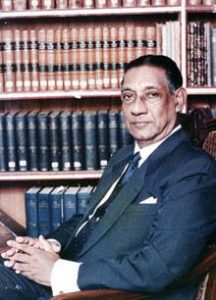
Hector Walter Jayewardene
Indira Gandhi gave a second telephone call to Jayewardene on 5 August 1983, a Friday. Her call had two objectives. First, to make Jayewardene accept India as the regional power and to make him realize the geo-political reality which he had ignored. Second, to obtain India a role in the resolution of the Tamil problem.
Gandhi thanked Jayewardene for receiving her Foreign Minister Narasimha Rao the previous week and for initiating a discussion with him. She also told Jayewardene that India appreciated the efforts he had taken to restore law and order in Sri Lanka.
Gandhi told Jayewardene the need to maintain peace in the region and the need to find a political solution to the problems of the Tamil people, a pre-requisite for peace in the region. She told him that India’s security interests require a reasonable solution to the Tamil problem and political stability in Sri Lanka. Jayewardene told Indira Gandhi he had commenced that process to work out a political solution to the Tamil problem on 20 July with the holding of the All Party Conference (APC) and intended to hold another meeting on 27 July, which he could not hold because of the disturbances. He referred her to the address he made to the cabinet on Wednesday, 3 August, which was published.
Indira Gandhi then referred to the passage of the Sixth Amendment in parliament early that morning (5 August) and told Jayewardene that that legislation would make it difficult for the Tamils to participate in the APC and suggested that India could help him to talk to the TULF about the solution.
Jayewardene accepted the suggestion and told her that he would send his younger brother H. W. Jayewardene as his special envoy within a week to discuss a political solution to the Tamil problem with her. He told her that his brother was a leading lawyer and a constitutional expert.
Indira Gandhi informed the Lok Sabah in the evening, in a statement during adjournment, about the telephone conversation she had had with Jayewardene. She told the House that President Jayewardene would send a special representative to New Delhi within a week to discus maintaining peace in the region and about finding a solution to Tamil problem.
H. W. Jayewardene reached New Delhi on 11 August and had two rounds of talks with Indira Gandhi. During the first round of talks held on 11 August Indira Gandhi conveyed to H. W. Jayewardene the deep concern of the Indian parliament and of the people of India regarding the recent violence against the Tamil people. She pointed out that India had always condemned such violence, killings and discrimination, especially when the victims are defenceless.
Then Indira Gandhi assured H. W. Jayewardene that India respected the independence, unity and integrity of Sri Lanka. She added, “India does not interfere in the internal affairs of other countries. However, because of the historical, cultural and such other close ties between the peoples of the two countries, particularly between the Tamil community of Sri Lanka and us, India cannot remain unaffected by such events there.” H. W. Jayewardene told her that the situation was fast returning to normal, Most of the refugees was returning to their homes, he said. He added the government was left with the problem of thousands of people who are left homeless. He told her that REPIA was created to protect the property of the affected Tamils and to help them to rebuild their houses. He denied the rumour that the government was trying to expropriate Tamil-owned property as baseless.
Indira Gandhi told H. W. Jayewardene of the Sri Lanka Relief Fund she had launched with a contribution of Rs. 10 million from the Prime Minister’s National Relief Fund. Public contributions were pouring in, she said. She added, “While action was being taken to meet the immediate situation, the process to find a permanent solution to satisfy the legitimate aspirations and ensure the security of the Tamil community will have to be urgently initiated.” H. W. Jayewardene told Indira Gandhi that President Jayewardene was already engaged in such a process. He said the President had to carry all sections of the people with him if he was to succeed in such an endeavour. Then he briefed her of the 5-point action plan President Jayewardene intended to place before the All Party Conference and suggested that could serve as the basis for a durable solution to the Tamil problem.
The 5-point action plan H. W. Jayewardene submitted had the following elements:
- Full implementation of the laws relating to the District Development Councils;
- The use of Tamil as provided in the constitution as a national language;
- To initiate dialogue on amnesty on condition that violence will be given up;
- Discontinuance of the active role of the armed forces in Jaffna on the cessation of terrorist violence; and
- The repeal of the Prevention of Terrorism Act.
Apart from submitting the action plan H. W. Jayewardene told Indira Gandhi that President Jayewardene was willing to discuss, if the idea of a separate state was abandoned, the release of those detained in prison not already convicted or awaiting trial and to implement any other assurance contained in the 1977 manifesto of the UNP.
Indira Gandhi told H. W. Jayewardene her view that that those proposals may not meet the aspirations of the Tamil minority.
H. W. Jayewardene told her that the Sri Lankan government was willing to consider any other proposals which would improve the DDCs.
Indira Gandhi suggested that the government should talk to the TULF, the democratically elected representatives of the Tamil people. H. W. Jayewardene told Indira Gandhi that the government had decided not to talk to the TULF till it dropped its separatist demand. Gandhi then offered India’s good offices and undertook to talk to the Tamil leaders. H. W. Jayewardene said he needed to consult the president before responding. Talks were adjourned so that H. W. Jayewardene could meet with Rao and Gandhi’s special adviser, Gopalaswamy Parthasarathy, to consider ways and means of improving the DDCs.
H. W. Jayewardene told Indira Gandhi during the second round of talks held on 12 August that President Jayewardene had accepted India’s good offices. He told her that President Jayewardene had appreciated her offer made in the context of the traditional ties between the two countries. He also conveyed President Jayewardene’s invitation to the Indian Parliament to send an all-party delegation to visit Sri Lanka. Indira Gandhi wrapped up the meeting with this comment, “The need of the hour is to reduce tensions and establish confidence. I hope that all concerned will feel able to meet at the conference table in an atmosphere of goodwill and mutual trust to settle their problems.” She told H. W. Jayewardene her intention to report to parliament on her talks with him and offered to reflect in her statement any perception to which Sri Lanka attached special importance.
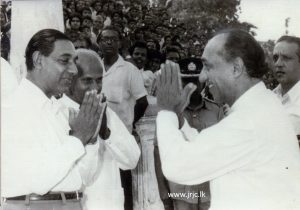
H.W. Jayawardene & J.R. Jayawardene
Officials from both sides were asked to prepare the draft of the statement. When they started drafting the statement, Indian officials said their prime minister intended to call for a settlement within the framework of a ‘united’ Sri Lanka. Someone on the Sri Lankan side immediately took issue and pressed for the replacement of the word ‘united’ with the word ‘unitary.’ H. W. Jayewardene soon intervened and told the Sri Lankan official that Sri Lanka should not put words into the mouth of the Indian Prime Minister. She must have her preference. Sri Lankan High Commissioner Bernard Tilakaratna supported that view.
Indira Gandhi made a statement to parliament that evening. She informed the House that H W Jayewardene, the personal representative of President Jayewardene, was in New Delhi. In discussion with him, she said, she had conveyed the concerns of the Indian parliament and the people of India. She said the Sri Lankan president’s representative had mentioned certain proposals President Jayewardene had intended to place before the Roundtable Conference in late July which did not take place.
She added, “I expressed my view that these proposals may not meet the aspirations of the Tamil community. The Sri Lankan special envoy H W Jayewardene said that the Sri Lanka government was willing to consider any other proposals which would give the Tamil minority their due share in the affairs of the country within the framework of a united Sri Lanka.

Indira Gandhi
“I gave my view that discussion between the government and the Tamil community on this broader basis would be useful and that a solution has to be sought at the conference table. I offered our good offices in whatever manner they may be needed. Mr. Jayewardene expressed his appreciation of this offer made in the context of traditional friendly ties between our countries. He later informed me that his president welcomes the offer,” she said.
The statement Indira Gandhi made to the Lok Sabah on 12 August clearly laid down the basis for the solution of the Sri Lankan Tamil problem.
The principles laid down were:
-Solution within the framework of a united Sri Lanka
-Solution should satisfy the aspirations of the Tamil people.
She also laid down that the solution should be worked out with the help of an intermediary.
A solution to the Tamil problem that satisfies the aspiration of the Tamil people within the framework of Sri Lanka continues to be the solution India has advocated since the time of Indira Gandhi.
Some ministers expressed unhappiness about the use of the word ‘united’ in Indira Gandhi’s statement when H. W. Jayewardene returned to Colombo. They argued that at least Sri Lanka’s reservations about the use of the word ‘united’ should have been indicated. H. W. Jayewardene stood his ground and said India should decide its policy and not Sri Lanka. Amir Meets Indira
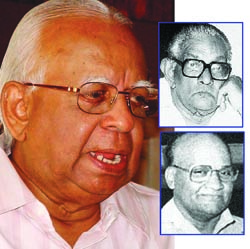
R. Sampanthan, M. Sivasithamparam and A. Amirthalingam
Amirthalingam and other members of parliament of the TULF were in Vavuniya when the riots broke out on 25 July. At the Mannar Convention, the TULF decided not to negotiate with the government. While in Vavuniya, Amirthalingam received on 29 August Indira Gandhi’s message: Come to India; we will give all assistance. But Amirthalingam could not leave Vavuniya. If he were identified on the way, he would be killed. He maintained contact with Indian High Commissioner Chhatwal who made arrangements for his travel to Delhi. Chhatwal also arranged for Sivasithamparam and Sampanthan to accompany him.
TULF parliamentarians met at Vavuniya on 6 August and decided not to take the oath of disavowal of separation under the Sixth Amendment. They decided to permit the Tamil government servants to take their own decisions about the oath.
The matter was considered by the LTTE High Command. Pirapaharan took up the position that the matter was a humanitarian problem. He said taking the oath does not mean anything. The officers could continue to support the Tamil Elam cause even after taking the oath. He argued that they should not heap an additional burden on the government servants and their families. Most of them were affected by the riots. “We should not throw them on to the streets through our decision,” he said.
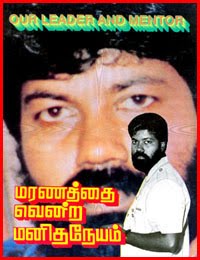
Kandasamy Pathmanabha
The EPRLF took a different line. Pathmanaba, its leader, said resistance to Sinhala domination should be shown, at least symbolically. Government servants should be asked not to take the oath of allegiance, he decreed. Then he left for India. PLOTE and EROS did not take any decision. Their leaders were in Tamil Nadu.
Pathmanaba’s decision was implemented by a small group of seven cadres led by Ramesh. Others in that group were Subathiran, Mohan, Suthan, Kumar, Indiran and Elango. They entered government offices and tore up the forms. They burnt a few state vehicles, including a police jeep.
EPRLF’s resistance did not have any impact. The concern of the Tamil officers was to retain their jobs. Lake House also asked its employees to take the oath. I signed the form and handed it to my editor. Everyone forgot about it thereafter.
Amirthalingam undertook a perilous journey to reach Colombo. He travelled on the pillion of a motorcycle. In Colombo, he was taken care of by Indian High Commission officials. He flew to Chennai on 11 August. At Chennai he was received by Indian Minister of State for Home Affairs, P. Venkatasubbaiah and Indian Foreign Secretary K. S. Bajpai, who had flown from Delhi for that purpose. Era Cheliyan, opposition Janata Party MP, was also present.
Amirthalingam spent the night in Chennai and called on Chief Minister M. G. Ramachcndran and DMK leader Karunanithi. He flew the next day, 12 August, to Delhi. Foreign Minister Narasimha Rao joined him in the flight at Hyderabad. They had a discussion during the flight. At Delhi Rao took Amirthalingam to the airport lounge where he addressed newsmen.
Amirthalingam told the media that the Tamils decided to demand a separate state for themselves after their attempts to work out a settlement were spurned. They tried hard to work with the Jayewardene government even after taking the separatist decision in 1976 at Vaddukoddai, he said. They had tried to make the DDC system work despite opposition from armed groups. They found it unworkable because it lacked power and funds. When they asked for them, they were attacked, Amirthalingam said.

Sampathan, 2002
He said, “India and the international community are now our saviors. We have lost our trust in Jayewardene and his government. There is no use talking to them any more. They are out to destroy the Tamils.” Amirthalingam, Sivasithamparam and Sampanthan, the TULF triumvirate, called on Indira Gandhi on 14 August. Indira Gandhi’s secretary P. C. Alexander and her advisor Gopalaswami Parthasarathy were present. They discussed the Sri Lankan situation for over two hours. The discussion centered round the Tamil problem, the possible solution and India’s role.
Amirthalingam gave a brief summary of the Tamil problem, the non-violent struggle led by Federal Party leader S. J. V. Chelvanayakam and its failure. He identified the immediate need of the Tamil people is to live in safety and security in the north-east where they are a majority community. He summed up, “All we asked was an autonomous region under a federal set up. Since that was refused we demanded a separate state.”
Indira Gandhi outlined to the three the Indian policy towards the Tamil problem. She told them that India is opposed to the division of Sri Lanka. She told them India would not support a separate state in Sri Lanka. She explained that Tamils should opt for something less, an autonomous region within a united Sri Lanka. “Get back to your original demand and India will back it,” Indira Gandhi told the TULF leaders.
Sampanthan told me that Indira Gandhi told them emphatically that she would not take sides in the Sinhala-Tamil conflict. All she could and would do was to get justice for the Tamils without harming the overall interests of the Sinhala people. Her effort would be to make the Tamils live in Sri Lanka with dignity, security and self-respect. That she would try to do without harming the larger interests of the Sinhalese.
Amirthalingam readily accepted Gandhi’s plea and told her he would be satisfied if the aspirations of the Tamils in the Northern and Eastern provinces were met. He told Indira Gandhi that Tamil aspirations had been identified by their leader S. J. V. Chelvanayakam and embodied in the Federal Party’s Trincomalee Convention held in 1956. He told Indira Gandhi that Chelvanayakam identified Tamil aspiration as:
- Tamil Nationhood,
- Tamil homeland,
- Right of Self-determination and
- Citizenship.
Indira Gandhi, then, briefed the TULF leaders of the meeting she had had with H. W. Jayewardene. She told them that President Jayewardene had offered to strengthen the DDC scheme. She had told H. W. Jayewardene her view that that would not satisfy the aspirations of the Tamil people. President Jayewardene had offered to consider other suggestions. He had offered to hold the All Party Conference. Then she asked the TULF leaders whether they were prepared to attend the APC.
Amirthalingam told her of the decision taken at the Mannar Convention not to negotiate with Jayewardene any further. He told her that Jayewardene would agree to requests, but would not implement them. He told her of the bad experience he had with Jayawardene during the 11-month talks TULF had had with him.
“We have lost confidence in negotiations with the Sri Lankan government because the agreements reached in the past were not implemented,” Amirthalingam told Indira Gandhi. She told the three that she also had no confidence in Jayewardene. But they should not turn down an invitation for talks. Then she reiterated, “As I have said before, a solution to this problem has to be sought at the conference table.” Amirthalingam told her he appreciated her position and indicated his willingness to cooperate.
Indira Gandhi was impressed with Amirthalingam’s decision. She invited him as a special guest for India’s Independence Day celebrations the next day, August 15. He was accommodated on the dais, at the historic Red Fort, an honour normally accorded to head of states or heads of governments. Amirthalingam was only the Leader of the Opposition. Addressing the nation from the ramparts of the Red Fort, Indira Gandhi condemned the violence against the Tamils in Sri Lanka. She called it genocide. She declared that India would help the Tamil people to live with dignity and security.
 Jayewardene was incensed. He ordered the state media to launch a virulent campaign against Indira Gandhi and India. They questioned Indira Gandhi’s credibility and impartiality. They called India a ‘Big Brother’ who was trying to twist the hands of a small country. They questioned the special treatment accorded to Amirthalingam and the strongly worded statement Gandhi made.
Jayewardene was incensed. He ordered the state media to launch a virulent campaign against Indira Gandhi and India. They questioned Indira Gandhi’s credibility and impartiality. They called India a ‘Big Brother’ who was trying to twist the hands of a small country. They questioned the special treatment accorded to Amirthalingam and the strongly worded statement Gandhi made.
The TULF, on the other hand, softened its stand. Amirthalingam told the media in Delhi that their meeting with Indira Gandhi had “changed the picture.” He said, “With India’s good offices, a basic change had come about.”
Amirthalingam also announced the altered TULF position. He said the TULF would be prepared to give up its demand for a separate state of Tamil Eelam if the government offered a ‘practical alternative.’ He said his party was prepared to accept a reasonable alternative and would persuade the Tamil people to accept it. He hinted that that alternative should be a federal arrangement that permits the Tamil people to rule themselves.
He insisted that for such a settlement to be reached, India’s role is important. He said India should upgrade its role from providing its ‘good offices’ to that of an active mediator. He cited the role the United States played in the Camp David talks as a model. He added that India should guarantee any agreement reached.
Jayewardene rejected Amirthalingam’s suggestion. He told the media that India should, at the moment, keep a low profile and added that Indian mediation should be “kept in reserve.”
Amirthalingam returned from Delhi to an emotionally charged Tamil Nadu. The ‘Pilgrimage to Eelam’ Nedumaran started on 7 August had failed. But the 8-day 1700-kilometer march of 5,000 volunteers had stirred Tamil emotion to the boil. Thousands of emotion-charged men, women and children joined the march as it wended its way from Madurai to Rameswaram, the two temple towns Pirapaharan lived in and loved.
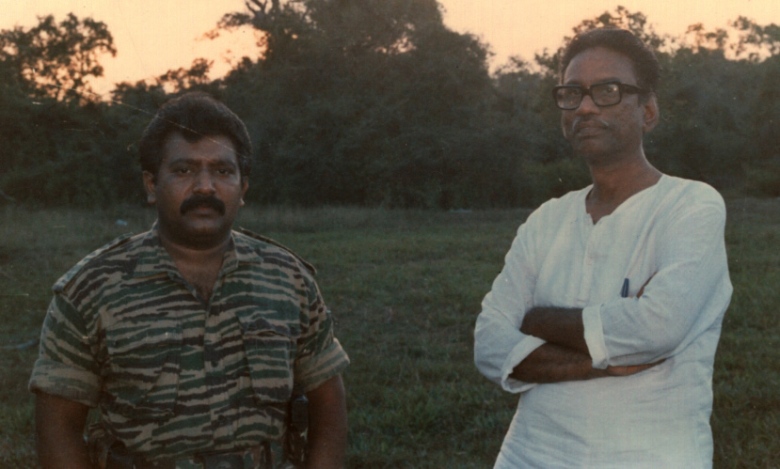
Prabakaran & Nedumaran, probably late 1980s
Nedumaran planned to cross the Palk Straits to Jaffna in a flotilla of fishing boats. Colombo and Delhi were thoroughly upset by Nedumaran’s plan. Jayewardene ordered his tiny navy to block boats from crossing. Delhi, fearing an unwanted conflict, decided to abort it. Indira Gandhi told M. G. R. to prevent Nedumaran’s crossing to Jaffna. MGR handled the matter by depriving Nedumaran of boats. He got the police to move away all fishing boats from that coastal area. Nedumaran and his followers who reached the Rameswaram coast on 15 August, India’s independence day, found, to their astonishment, only two leaking boats available. Nedumaran got into one and ordered its owner to set sail. The protesting owner could sail only a few minutes. He returned to the beach with the boat half filled with water.
An infuriated Nedumaran shrieked, “MGR had done this. Arrest me. Arrest me.” Policemen watched in amazement.
Karunanithi and DMK general secretary K. Anbhazagan, capitalized on the emotional swell. They resigned their seats in the Tamil Nadu Assembly on 10 August to express solidarity with the Sri Lankan Tamils. The Speaker refused to accept the resignation letters, citing technical reasons. But the DMK leaders kept away from the legislative assembly and issued statements accusing Delhi of treating the Bangladesh and Sri Lankan Tamil problems differently. They accused MGR. for not pressing the Tamil case with Delhi. DMK newspapers hinted at MGR’s Malayali origin and his birth in Kandy as the causes for his playing down the Sri Lankan Tamil problem.
Stung by this accusation, MGR summoned an All Party Conference to press Delhi to act. The DMK boycotted the conference. But the All Party Conference passed a resolution calling for Delhi’s intervention.
Amirthalingam returned to Chennai on 16 August. He called on Chief Minister M. G. Ramachandran. Then he wanted to meet Karunanidhi. The DMK leader was annoyed that Amirthalingam had met MGR before him. He refused to give an appointment saying he would be in Trichi for three days. Amirthalingam went to Trichi and pacified him.
Third Call

Portrait of M. Karunanidhi
Briefed of the growing resentment in Tamil Nadu against Delhi’s failure to act tough in Sri Lanka’s case, Indira Gandhi made her third telephone call to Jayewardene on August 17. She told him of the growing agitation in Tamil Nadu in favour of armed intervention by India. She said the commencement of the process to work out a solution to the Tamil problem would sooth the feelings in Tamil Nadu. She said that she would send Parthasarathy as her special envoy to meet Jayawardene and start negotiations to find a solution to the Tamil problem.
Jayewardene, who was in the midst of an interview with Colombo-based Indian journalists when he received the call from Indira Gandhi, asked the journalists, “Who is this Parthasarathy?” He learnt that the 73-year-old Gopalaswamy Parthasarathy was a special advisor to the prime minister on foreign affairs, who was chairman of the government’s Policy Planning Committee and a member of the family that owned the Hindu newspaper of Chennai.The next day, 18 August, Indira Gandhi informed the Indian Lok Sabah, “Yesterday, I once again telephoned President Jayewardene. I have offered to send a special envoy to meet President Jayewardene and others. During my telephone call last evening, President Jayewardene agreed to my suggestion. Accordingly, I have asked one of our distinguished and experienced diplomats, Shri G Parthsarathy, to undertake this delicate and important task. He will visit Colombo next week.”

Gopalaswamy Parthasarathy
An important question now crops up. What prevented Indira Gandhi from invading Sri Lanka as she did Bangladesh? India invaded Bangladesh because it helped to weaken its main enemy Pakistan. Formation of Bangladesh removed forever the threat of simultaneous attack from the western and eastern wings of Pakistan on India. India did not invade Sri Lanka because it would weaken the defence of its southern flank.
The picture Delhi’s security advisors presented to Indira Gandhi was this: If you invade and help create Tamil Eelam you create two nations in the island of Sri Lanka – Tamil Eelam and Sri Lanka. Tamil Eelam may be friendly to India, but Sinhala-dominated Sri Lanka would be permanently unfriendly. Sri Lanka would then be the playing field for anti-India forces. That would be inimical to Indian security interests. Indian security interests require, the experts told her, a united Sri Lanka where anti-Indian forces are not allowed to take root. Indira Gandhi held a series of discussions with the members of the Political Affairs Committee and with the leaders of the political parties with representatives in parliament The policy framework which emerged from those discussions has been christened the Indira Doctrine by strategic affairs analysts like Dr. Bhabani Sen Gupta. They also called it the “Indian Doctrine of Regional Security.” Dr. Gupta explained the Indira Doctrine in the following terms:
- India has no intention of intervening in the internal conflicts of a South Asian country and it strongly opposes intervention by any country in the internal affairs of any other.
- India will not tolerate external intervention in a conflict situation in any South Asian country, if the intervention has any implicit or explicit anti-Indian implication. No South Asian government must therefore ask for external military assistance with an anti-Indian bias from any country.
- If a South Asian country genuinely needs external help to deal with a serious internal conflict situation, or with an intolerable threat to a government legitimately established, it should ask help from a number of neighboring countries including India. The exclusion of India from such a contingency will be considered to be an anti-Indian move on the part of the government concerned.
India did not invade Sri Lanka because it told the nations, including the ones from which Sri Lanka asked for arms aid, that it had no intention of intervening in her internal conflict and it would not tolerate their intervention. Hence, Indira Gandhi was left with the option of providing its good offices.
I want to recall an exchange that took place in a foreign policy seminar held in Colombo about 15 years ago. The then Opposition Leader Anura Bandaranaike blamed President Jayewardene for seeking arms aid from foreign countries. “You asked for arms, but got nothing,” he said. Lalith Athulathmudali intervened and said, “Yes. We did not get arms. India blocked it. India blocked by telling those countries that it had no intention of invading Sri Lanka. So we asked for arms and got the Indian government to abandon its intention to invade Sr Lanka.” The July riots, we say, are the turning point in Tamil freedom struggle and Sri Lankan history. We must add, the first 17 days of August were the days that decided the extent of the freedom Tamils and the Sinhalese would be permitted in the future. That freedom was to be governed by India’s policy regarding the solution to the Tamil problem and the Indira Doctrine. Index to previous chapters